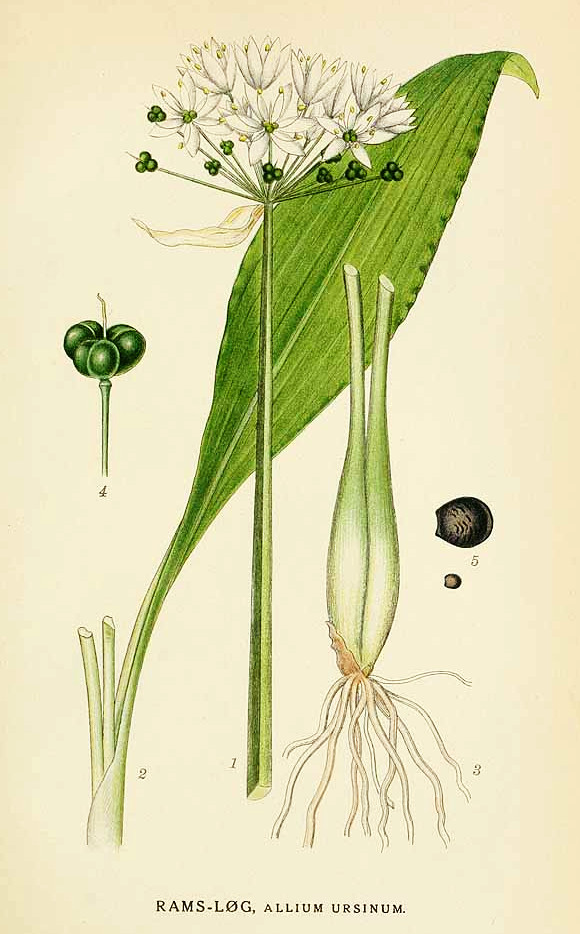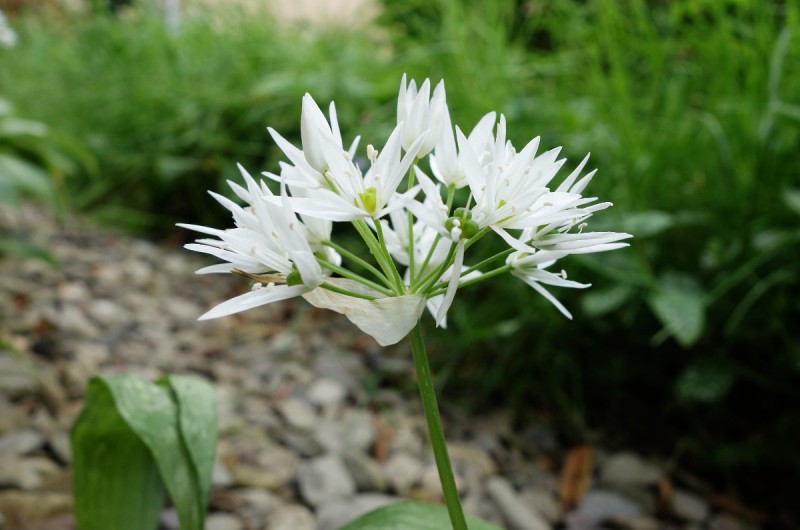Benutzer-Werkzeuge
Allium ursinum L. - Liliaceae - bear garlic, ramsons, gypsy onion, wild garlic, wood garlic, Bärlauch, Bären-Lauch, Rams
Perennial herb, up to 50cm high, native to Europe and Western Asia, cultivated in Europe; leaves basal, long-petioled, elliptic-lanceolate; inflorescence a rich-blossomed umbel; flowers pure white.
„The leaves of A. ursinum are edible; they can be used as salad, herb, boiled as a vegetable, in soup, or as an ingredient for pesto in lieu of basil.“
http://en.wikipedia.org/wiki/Allium_ursinum
„Dipropenyldisulfide, methylpropenyldisulfide, cis-propenylpropyldisulfide, diallylsulfide, dimethyldisulfide and 3-methylthiopropene were detected in the atmosphere of a beech forest with Allium ursinum (broad-leaved garlic) ground cover plants. Furthermore, it was shown that the Allium plants were the source of the organic sulfur compounds. The atmospheric concentrations of the organic sulfur observed on one day in May 1994 in a suburban forest in Vienna ranged from 0.3 to 7.8 ppb S with an average level of 2.9 ppb S. The atmospheric emission rate of organic sulfur species from A. ursinum determined with an enclosure box was the highest ever reported for terrestrial continental plants.“
[Observation of dipropenyldisulfide and other organic sulfur compounds in the atmosphere of a beech forest with Allium ursinum ground cover., Puxbaum, H., König, G., Atmospheric Environment, Vol.31(2), 1997, 291-294]
„Sulfur-containing compounds of ramson (Allium ursinum L.) are responsible for its traditional use in terms of culinary and medicinal purposes. Leaves and bulbs were investigated for their contents of cysteine sulfoxides (volatile precursors) as well as volatile compounds released from minced plant material…
The quality and quantity of volatiles significantly depended on the time of harvest. The highest amounts of volatile precursors can be gained in March and April, shortly before flowering time (up to 0.4% of total cysteine sulfoxides). The main cysteine sulfoxides were alliin and isoalliin. It has been found that alliinase of A. ursinum exhibited properties similar to those of alliinase of garlic (Allium sativum L.), but differing in terms of substrate specificity.“
[Chemical characterization of Allium ursinum L. depending on harvesting time., Schmitt, B., Schulz, H., Storsberg, J., Keusgen, M., Journal of agricultural and food chemistry, Vol.53(18), 2005, 7288-7294]
„A. ursinum and A. sativum exert similar antiaggregatory effects: they inhibit platelet aggregation induced via the ADP pathway and to a lesser extent aggregation induced by epinephrine, whereas ARA-, collagen- and A23187-induced aggregation was not affected. It became clear that the alcoholic extract of A. ursinum is the potent form, while the aqueous extract exerted an unspecific activity. The effects were strictly dose related. A. ursinum and A. sativum extracts exhibited similar potencies.
Both A. ursinum and A. sativum exert antiaggregatory effects. Garlic extracts are acting by inhibition of the ADP pathway; their mechanisms of action are comparable to that of the clinically used drug clopidogrel. The pharmacologically active component of the extracts appears to be lipophilic rather than hydrophilic, but the precise chemical substance is still unknown. This is the first report on the antiplatelet activity of A. ursinum.“
[Antiplatelet activity of Allium ursinum and Allium sativum., Hiyasat, B., Sabha, D., Grotzinger, K., Kempfert, J., Rauwald, J.W., Mohr, F.W., Dhein, S., Pharmacology, Vol.(83), 2009, 197-204]
„It has been estimated that cysteine sulfoxides (alliin) and the non-volatile γ-glutamylcysteine peptides make up more than 82% of the total sulfur content of ramsons. The thiosulfinates, ajoenes - a degraded form of allicin - vinyldithiins and sulfides, however, are not naturally occurring compounds. Thiosulfinates formed in Allium are degraded to various polysulfides and ajoenes which also exhibit different degrees of antimicrobial activity. The volatile sulfur compounds show more potent inhibitory effects towards fungi than bacteria. To some extent, they are degradation products from the naturally occurring cysteine sulfoxide, alliin. When the bulb of the ramson is crushed, minced, or otherwise processed, alliin is released from divisions and interacts with the enzyme alliinase in adjacent vacuoles. Hydrolysis and condensation of the reactive intermediate (allylsulfenic acid) forms allicin…
Allicin itself is an unstable product and undergoes additional reactions to form other derivatives (products), depending on environmental and processing conditions. Extraction of leaves of ramson with ethanol at <0 °C gave alliin; extraction with ethanol and water at 25 °C led to allicin and no alliin; and steam distillation converted the alliin totally to diallyl sulfides. The content of alliin was also affected by the processing treatment: leaves of ramson (fresh) contained 0.25–1.15% alliin, while material carefully dried under mild conditions contained 0.7–1.7% alliin.
Gas chromatography is used to separate the components of a mixture while mass spectroscopy can then characterize each of the components individually. Problems, when using these methods, may occur because of the release and activity of the above mentioned compounds during material preparation, as this might change the composition of the material to be analysed. The most abundant of the volatile compounds from A. ursinum were diallyl disulfide (19.98), diallyl trisulfide (38.74), 3-vinyl-(4H)-ditiin-1,2 (42.90) and 2-vinyl-(3H)-1,3-ditiin (57.87).
The extracts from Allium ursinum plants, inhibited growth of cells of Candida spp. at concentrations ranging from 0.5 to 4.0 mg/mL, while that of adherent cells at concentrations ranging from 1.0 to >4.0 mg/mL, depending on the yeast and plant species.
From the results obtained it is possible to conclude that the allicin and S-methyl cysteine sulfoxide isolated and identified in this work, as well as the mixes of volatiles generated by these two compounds, were capable of inducing antifungal activity.“
[Chemical composition and in vitro antifungal activity screening of the Allium ursinum L.(Liliaceae)., Bagiu, R.V., Vlaicu, B., Butnariu, M., International journal of molecular sciences, Vol.13(2), 2012, 1426-1436]

Lindman, C.A.M., Bilder ur Nordens Flora, vol.2, t.387 (1922-1926)
http://plantgenera.org/species.php?id_species=41608

Allium ursinum flowers, CC BY-SA 3.0, Author: Andreas Kraska

